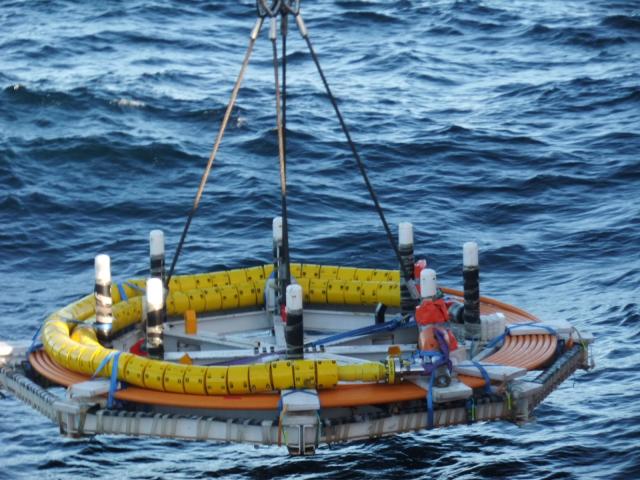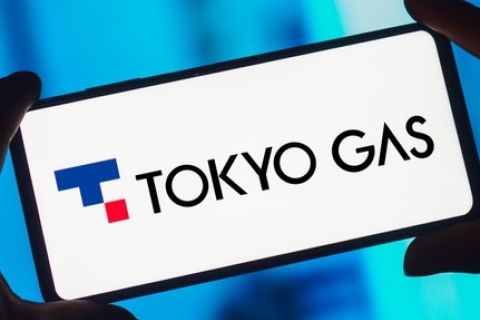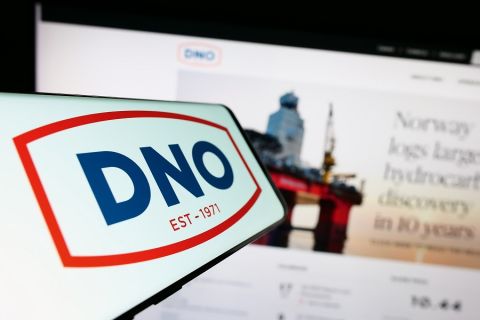
An HP/HT composite jumper is being supplied for the Alder Field developments. (Source: Airborne Oil & Gas and Chevron North Sea Ltd.)
Subsea production might have been born in the Gulf of Mexico (GoM) and used offshore Brazil before the 1980s, but it was in the U.K. sector of the North Sea that it grew from infancy to maturity.
Beginning with the Shell/Esso Underwater Manifold Centre and carrying on with shallow-water projects by Amerada Hess (now just Hess), then by BP west of the Shetlands beyond 400 m (1,312 ft) and even Chevron’s recent Alder HP/HT 28-km (17-mile) subsea tieback, the British sector has not been short of ambition, adventure, enthusiasm and risk-taking. Combined with what was happening across the median line in Norwegian waters—TOGI, Snorre, Statfjord Satellites, Troll West, et al., in the 1990s; and Ormen Lange, Tordis, et al., in the 21st century—the North Sea was where it was at as far as subsea technology went, at least until the expansion into West Africa since 2000.
Scroll forward to the present, and what is found today is a British offshore sector in a major funk. The oil price crash of late 2014 had much to do with it, but there are other significant factors as well. Years of underinvestment in exploration, much of it the result of ennui by the majors who have been elephant hunting elsewhere in the world, has left the sector with a portfolio of mostly minifields, 350 at last count, that will require clever thinking to develop.
In addition, the sector has long been known as a highcost location, both for capex and opex. Finally, the sector hardly ever really received any support from various governments, which only ever saw it as a cash cow and never as the vibrant industrial sector that employed a workforce of more than 400,000 at its peak, more than the automotive industry, which has always been flagged as a British success story.
Finally taking notice
The price crash finally focused everyone’s attention on what was needed, although an important part of the process actually began more than a year before. A sector- wide analysis undertaken by Sir Ian Wood in 2013 and presented in February 2014 added a new phrase to the offshore lexicon—“maximum economic recovery”— and sent the U.K. down a path it had never been before, trying to save the offshore sector.
In parallel with this localized approach, there had been the industry drive to reduce costs, and it was urgent. This as well had actually begun before the crash. One can go back to the early part of 2013 to find operators who were already applying the brakes to big deepwater projects. For example, BP’s original scheme for the expansion of the Mad Dog Field (Mad Dog 2) in the GoM put forward in 2013 had a price tag of $20 billion. No way, said management—go back and look again. So it did, and the development scheme, described as more standardized, was sanctioned at the beginning of December last year with a price tag of $9 billion.

BP would like to take most of the credit for this major capex reduction, which it said is due to a less expensive semisubmersible floating production system, and it certainly deserves some plaudits. It also, though, had the opportunity to re-tender the whole project at a time when there was a dearth of big projects going ahead and could have benefited from general cost reduction in equipment and services across the industry.
Recommendations and studies
The Wood report made a number of recommendations, one of which was the creation of a new industry regulator. More than a few observers expressed wonderment at how a new regulatory body could make a difference to the future of the sector. If what has been learned only recently of the work the Oil & Gas Authority (OGA) has undertaken, the naysayers have been proven wrong already.
If the future of the U.K. sector is to be based on the portfolio of marginal fields (fields with less than 50 MMboe in reserves), a significant majority—about 200—will be developed as tiebacks to existing infrastructure, and many, and possibly most, will be developed using subsea wells.
The OGA already has taken on board the need to ensure that the right technology is available to all operators. In what must have been an unprecedented action by a U.K. regulator, it commissioned four studies to determine the economic viability of fields that might make use of specific technology and what the impact might be. There seems to have been some collaboration—a current favorite buzzword—between OGA and Oil & Gas UK’s Efficiency Task Force. The latter body is an association of operators and main contractors.
Two of the studies involved looking at conventional subsea tiebacks and making use of already proven but less expensive pipeline tie-in technology, which produced savings of 18% to 28% on project capex. Some of the technologies identified as applicable in such cases are mechanical rather than welded hot taps, mechanical connectors as an alternative to welded pipe and spooled pipelines and composite pipe such as is being offered by Airborne Oil & Gas and Magma Global.
The other studies looked at riser systems for FPSO units and a different configuration of pipeline bundles with integral manifolds. Again, savings of 15% to 25% were suggested.
OGA also has looked at and identified technologies that might be applicable for low-cost standalone developments, which represent nearly one-third (120) of the marginal fields. Some of the options include unmanned production buoys; a mini-FPSO unit; subsea storage, which might eliminate the need for a long pipeline tieback; and the much used “subsea factory” term, which would involve some form of seabed processing prior to export.

Cluster development
What makes OGA’s actions seem unfathomable compared with its predecessors is that it also has analyzed the marginal field portfolio and developed a strategy, or “cluster collaboration” for want of a better term, based on field location, proximity to infrastructure and proximity to other finds. It also has looked at some specific clusters to see how they might be developed.
Already analyzed is the West Sole Catchment Area in the U.K.’s Southern North Sea Gas Basin, with combined proven reserves of at least 14 Bcm (500 Bcf). This cluster includes Centrica’s Olympus discovery, Dana Petroleum’s Platypus find, two small Premier fields and one held by Hansa Petroleum plus one relinquished find (Glein West) and at least six other prospects.
One challenge that often has reared its head in the sector is alignment of development priorities. This cluster, for example, has four operators and 11 licensees, some of them small. Trying to get this group to agree to a development scenario, timetable and program is not an easy task. One advantage that OGA has is control of licenses. To make this cluster more economic, it could throw the relinquished find into the mix to benefit the entire development.
OGTC
Bolstering OGA’s enterprise was the formal launch in February of the Oil & Gas Technology Centre (OGTC) in the U.K. One of its first tasks is its “small pools” initiative, which is running parallel to the work on marginal fields. Even before the launch OGTC’s team had thrown down the gauntlet by declaring that it is aiming to eliminate stranded assets by 2025, a rather bold declaration.
Two of the technologies that are at the top of its wish list involve gas handling and umbilical-less subsea systems.
Disposal of associated gas that comes with small oil finds has often in the past been a major roadblock to development as the options—flaring in the case of an FPSO unit or small platform or drilling a gas disposal well as part of a subsea development— are either environmentally or economically unpalatable.
As for eliminating the umbilical from the subsea system, this has been a desire for decades, but throughwater communications has a number of limitations that to date have not been overcome.
It has been suggested that technology developed for the military, such as that used with permanently deployed sensors on the seabed to track submarines, could be made available.
This is a challenge that will test the mettle of both engineers and regulators.
Editor’s note: Steve Sasanow is the former editor of Subsea Engineering News.
Recommended Reading
DXP Enterprises Buys Water Service Company Kappe Associates
2024-02-06 - DXP Enterprise’s purchase of Kappe, a water and wastewater company, adds scale to DXP’s national water management profile.
ARM Energy Sells Minority Stake in Natgas Marketer to Tokyo Gas
2024-02-06 - Tokyo Gas America Ltd. purchased a stake in the new firm, ARM Energy Trading LLC, one of the largest private physical gas marketers in North America.
California Resources Corp., Aera Energy to Combine in $2.1B Merger
2024-02-07 - The announced combination between California Resources and Aera Energy comes one year after Exxon and Shell closed the sale of Aera to a German asset manager for $4 billion.
Vital Energy Again Ups Interest in Acquired Permian Assets
2024-02-06 - Vital Energy added even more working interests in Permian Basin assets acquired from Henry Energy LP last year at a purchase price discounted versus recent deals, an analyst said.
DNO Acquires Arran Field Stake, Continuing North Sea Expansion
2024-02-06 - DNO will pay $70 million for Arran Field interests held by ONE-Dyas, and up to $5 million in contingency payments if certain operational targets are met.





